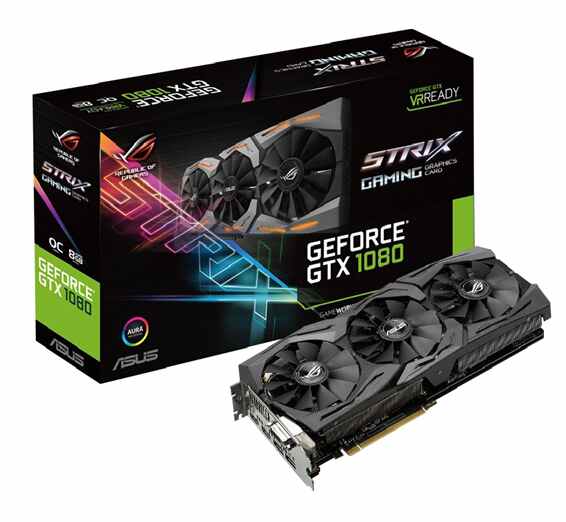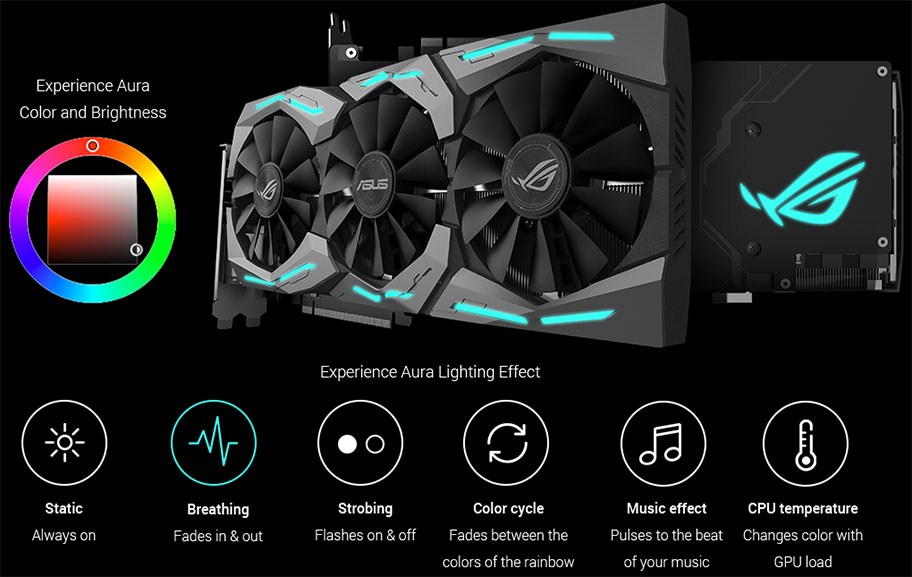Asus Gives The GTX 1080 A Strix Overhaul
Nvidia revealed the GeForce GTX 1080 at the beginning of May to much fanfare. The company announced that Founders Edition cards (reference) would be available and that partners would be free to launch their own custom cooled and overclocked cards on May 27. Asus didn’t waste any time preparing the Strix edition cards.
The GeForce GTX 1080 is the first Pascal based GPU to hit the market. It features 2560 Cuda cores and 160 texture units, and under Nvidia’s specification, it operates at 1607 MHz (1733 MHz boost). Partners are of course free to adjust the clock speeds as they see fit to take advantage of their advanced cooling solutions, and Asus has done just that with the two Strix models.
The Asus Strix GeForce GTX 1080 cards come equipped with the company’s Direct CU III cooler that runs copper heatpipes directly over the GPU and spread out through a large array of vertically-mounted fins. Asus cools the heatsink with three wing-blade 0-dB fans that spin down when the card is at idle or processing a light workload. Asus said the wing-blade fans are tuned for maximum static pressure and claimed that the Direct CU III cooler offers 30% better cooling performance than Nvidia’s Founder’s Edition cooler.
The Asus Strix GTX 1080 cards are designed for better overclocking performance. In addition to the Direct CU III cooler, Asus has added a second power connection so the card can draw more, stable power. The cards also feature an 8+2 phase power solution that Asus said operates cooler and more efficiently than the reference design. The Asus Strix cards are also manufactured with the company’s Auto-Extreme technology, which ensures fewer manufacturing errors by automating the entire assembly process.
The Strix GTX 1080 cards come equipped with Aura RGB lighting. The front shroud of the card includes six different LED lights, and the backplate includes an illuminated Strix logo. The lighting can be customized, and Asus offers six different lighting modes, including static color, breathing and music effect. You can even make it react to the GPU temperature. The lighting effects for the GPU and other Aura-enabled components are independent, but Asus said a future software update will enable synchronization between the lights on the graphics card and Aura enabled motherboards.
Asus is also introducing an interesting new fan control feature along with the Strix GTX 1080 cards. Asus Fanconnect technology puts the GPU instead of the CPU in control of your chassis fans. Case fans have long been controlled by the CPU load through your motherboard, but these days GPU load doesn't necessarily mean there's heavy CPU load. Asus has put two fan headers directly onto the Strix GTX 1080 cards, allowing the GPU load to dictate the pace at which the case fans ramp up or slow down.
| Header Cell - Column 0 | ROG Strix GeForce GTX 1080 OC Edition | ROG Strix GeForce |
|---|---|---|
| Row 0 - Cell 0 | (STRIX-GTX1080-O8G-GAMING) | (STRIX-GTX1080-8G-GAMING) |
| Core Clock | 1898 MHz boost clock in gaming mode | 1607 MHz base clock |
| Row 2 - Cell 0 | 1936 MHz boost clock in OC mode | 1733 MHz boost clock |
| Interface | PCI Express® 3.0 | PCI Express 3.0 |
| Memory | 8GB GDDR5X | 8GB GDDR5X |
| Memory Interface | 256-bit | 256-bit |
| Display Interface | 1x Native DVI-D output | 1x Native DVI-D output |
| Row 7 - Cell 0 | 2x Native HDMI 2.0 outputs | 2x Native HDMI 2.0 outputs |
| Row 8 - Cell 0 | 2x Native Display Port 1.4 | 2x Native Display Port 1.4 |
| MSRP | $639.99 | $619.99 |
| Availability | June 4 | June 4 |
The Asus Strix GeForce GTX 1080 comes in two flavors. The standard Strix model has the same clock speed specifications as the Founders Edition card, but the company offers a factory-overclocked version, as well. The Strix OC model comes with two modes to choose from: Gaming Mode, which boosts as high as 1898 MHz, and the OC Mode, which boost all the way up to 1936 MHz. Asus said both cards have headway for further overclocking if you wish to gain even more performance.
Get Tom's Hardware's best news and in-depth reviews, straight to your inbox.
The Asus Strix GeForce GTX 1080 is part of Asus’s Beyond VR Ready program. Both cards exceed the necessary requirements to deliver excellent VR performance, but Asus took these one step further to make the cards more VR friendly. Each Strix GTX 1080 features two HDMI outputs so that you can hook up an HDMI display, such as a TV or a projector, to your computer, while an HMD, such as the Rift (which requires HDMI) can be plugged into the other one. Asus also includes two DisplayPort 1.4 outputs, which support G-Sync, as well as a DVI-D port.
Asus said the Strix GTX 1080 carries an MSRP of $619.99, and the Strix GTX 1080 OC sell for $639.99. Both cards will be available on June 4.
Follow Kevin Carbotte @pumcypuhoy. Follow us on Facebook, Google+, RSS, Twitter and YouTube.
Kevin Carbotte is a contributing writer for Tom's Hardware who primarily covers VR and AR hardware. He has been writing for us for more than four years.
-
turkey3_scratch Everybody who just bought the Founder's Edition is probably crapping their pants right now. Controllable LEDs that can even adjust based on temperatures, fan controllable ports, better and probably quieter cooling system, the OC version has way better stock clock rates. All $60 cheaper for the OC edition and $80 cheaper for the normal edition.Reply -
Nick_50 If I could afford it I would so get one of these, hopefully the 1070 version will be similar.Reply -
kcarbotte Reply18029043 said:Everybody who just bought the Founder's Edition is probably crapping their pants right now. Controllable LEDs that can even adjust based on temperatures, fan controllable ports, better and probably quieter cooling system, the OC version has way better stock clock rates. All $60 cheaper for the OC edition and $80 cheaper for the normal edition.
Nvidia said that partner boards would sell for as low as $599 while Founders edition cards will be $699.
If you're crapping your pants over that, you weren't paying attention to the announcements.
Founders Edition will be easier to watercool, at least for the time being, and the blower coolers are better suited for SLI.
There's reason to go with Founders, but if you don't fit those two niche categories, than an overclocked partner card will be a better choice. -
turkey3_scratch Reply18029149 said:18029043 said:Everybody who just bought the Founder's Edition is probably crapping their pants right now. Controllable LEDs that can even adjust based on temperatures, fan controllable ports, better and probably quieter cooling system, the OC version has way better stock clock rates. All $60 cheaper for the OC edition and $80 cheaper for the normal edition.
Nvidia said that partner boards would sell for as low as $599 while Founders edition cards will be $699.
If you're crapping your pants over that, you weren't paying attention to the announcements.
Founders Edition will be easier to watercool, at least for the time being, and the blower coolers are better suited for SLI.
There's reason to go with Founders, but if you don't fit those two niche categories, than an overclocked partner card will be a better choice.
I did pay attention to the announcements, and I know the afermarket cards are cheaper. This is exactly my point: non-founders cards are cheaper and better. I'm not crapping my pants; people who bought the founder's edition are.
Watercooling? What purpose is there to watercool a 180W card like the 1080? Even overclocked heavily it's only 225W, and as testing has shown. Watercooling is a complete gimmick. People cry for more efficient cards then they want to watercool for reasons that don't make sense to me. The only reason to watercool any Pascal GPU is to make the computer look nice and to tell your friends it is watercooled. The days where watercooling had true benefits are practically over; some CPUs may need watercooling for heavy overclocking, like a 5960X, but our modern day GPUs have no problem with air. -
elbert Reply
Point is the custom cards come with 8+6 pin or even 8+8 pin for higher OC.18029149 said:18029043 said:Everybody who just bought the Founder's Edition is probably crapping their pants right now. Controllable LEDs that can even adjust based on temperatures, fan controllable ports, better and probably quieter cooling system, the OC version has way better stock clock rates. All $60 cheaper for the OC edition and $80 cheaper for the normal edition.
Nvidia said that partner boards would sell for as low as $599 while Founders edition cards will be $699.
If you're crapping your pants over that, you weren't paying attention to the announcements.
Founders Edition will be easier to watercool, at least for the time being, and the blower coolers are better suited for SLI.
There's reason to go with Founders, but if you don't fit those two niche categories, than an overclocked partner card will be a better choice.
I did pay attention to the announcements, and I know the afermarket cards are cheaper. This is exactly my point: non-founders cards are cheaper and better. I'm not crapping my pants; people who bought the founder's edition are.
Watercooling? What purpose is there to watercool a 180W card like the 1080? Even overclocked heavily it's only 225W, and as testing has shown. Watercooling is a complete gimmick. People cry for more efficient cards then they want to watercool for reasons that don't make sense to me. The only reason to watercool any Pascal GPU is to make the computer look nice and to tell your friends it is watercooled. The days where watercooling had true benefits are practically over; some CPUs may need watercooling for heavy overclocking, like a 5960X, but our modern day GPUs have no problem with air. -
turkey3_scratch 8+8 for a 1080 feels excessive to me, but it depends on what overclocks can be achieved I suppose. The Founder's Edition clocked to 2100Mhz became a 225W card opposed to being a 180W card at stock clocks. 150W for 8-pin, 75W for 6-pin, and 75W for PCIe. It's been shown that the 1080 doesn't favor the actual PCIe slot as much as the PCIe adapters, yet still I don't see a scenario where this card would need an 8+8 pin unless we start achieving 2300Mhz about.Reply -
fil1p Looks good so far. The last couple Strix cards have been a bit disappointing in my opinion. The cooler hasn't been in good contact with the memory chips of the cards and the VRM's (cooled by a small secondary heatsink) aren't the best cooled either. I hope this is fixed as the memory and VRMs should be attached to the heatsink.Reply
I look forward to seeing the reviews!


